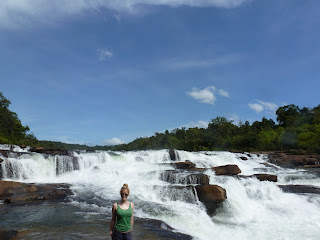And how we cherished our Beatle wagon, from the single-ringed, portable stove and classroom-style table to the ancient foam mattresses and safety-pinned curtains.

We turned up the radio, wound down the windows and headed south of Perth to explore the Margaret river area for the next week. The south-west coast of Australia is a land of vineyards and world-famous surf, where our first lunch-stop over-looking Geographe Bay served up accidental whale and seal watching across the blue, blue ocean. Life was good on the road, down under.
We pulled up in campsites on the cusp of the brilliant, turquoise coastline and in the heart of stunning National Parks, only meeting a handful of 'Grey Nomads' - exuberantly friendly Aussies who have been on the road since retirement.

We also met our first roo on arrival at our first National Park campsite. Right next to our camper was a mother and her baby joey, who immediately alerted their ears and eyes to our arrival.
The joey bounded around but, as we got closer, decided to hide and climbed right into his mum's pouch for safety. "How lucky we are!" we gasped. In fact, we would see hundreds of roos thereafter and we were surrounded each night we camped in Margaret River territory. Who needs television for evening entertainment?

We quickly got used to the bush-style, compost toilets in the National Parks and I soon forgot to check every toilet for spiders, snakes, unknown flying insects, massive biting ants and everything else before sitting down.
Australia has more things that can kill you than anywhere else and as many as a third of its species remain entirely unknown to scientists. Of the world's ten most poisonous snakes, all are from Australia. Not to mention the spiders, jellyfish, the blue-ringed octopus, the most lethal of their type in the world (to mention just a few). At this point, before any of you start thinking how brave I am, I have to admit that on my first day in Australia, I could be found erratically

checking the room, beds, even our clothes and bags for spiders - and we were still in the city centre. Camping in the bush for a month soon bashes that fear our of you; there would be no sleeping or exploring if you had man-eating spiders on the brain.
We certainly explored the area: sea, sun, surf, towering forests and vineyards. We learned how it felt to have our own private beach (we wouldn't have to share many all the way up the coast to Darwin) and there was no better feeling than watching the Australian sun bounce off the huge surf as the breeze tousled with our unwashed hair. Or perhaps there is: drinking locally produced "goon" (an Aussie term for cheap boxes of wine -"goon" is derived from the word "flagon" (a drinking vessel), but mistakenly thought to be an Aborigine name by tourists (goons!)) and cooking a BBQ by a river with no one else around, just the roos and possums for company.

In this small pocket of south-west Australia, we were free, we had our independence and it was exhilarating. Thankfully, we were heading north the day the controlled bush fires got out of hand and destroyed large areas of forest and people's homes. A reminder of the vast, and often unruly country we are in.






































 as we made our way along in the dark and dirt. We bailed out early (you can walk 100 metres) and it was a relief to see sunlight again, I can tell you!
as we made our way along in the dark and dirt. We bailed out early (you can walk 100 metres) and it was a relief to see sunlight again, I can tell you!





 during Happy Hour(s) and keeping them in the fridge behind the bar, tucking in with our fingers to platefuls of fresh seafood, and nursing bad sunburn (not mine, for I'm still obsessed with the factor 30).
during Happy Hour(s) and keeping them in the fridge behind the bar, tucking in with our fingers to platefuls of fresh seafood, and nursing bad sunburn (not mine, for I'm still obsessed with the factor 30).